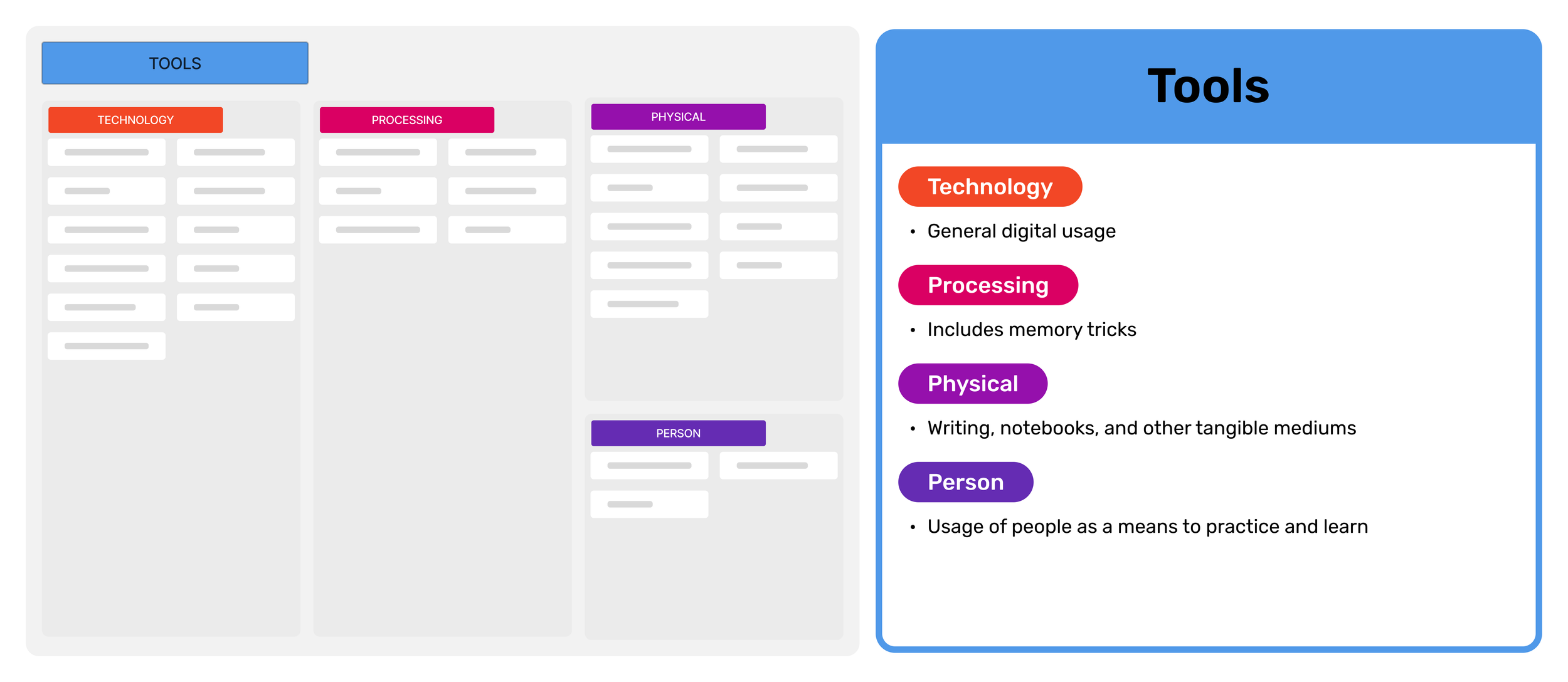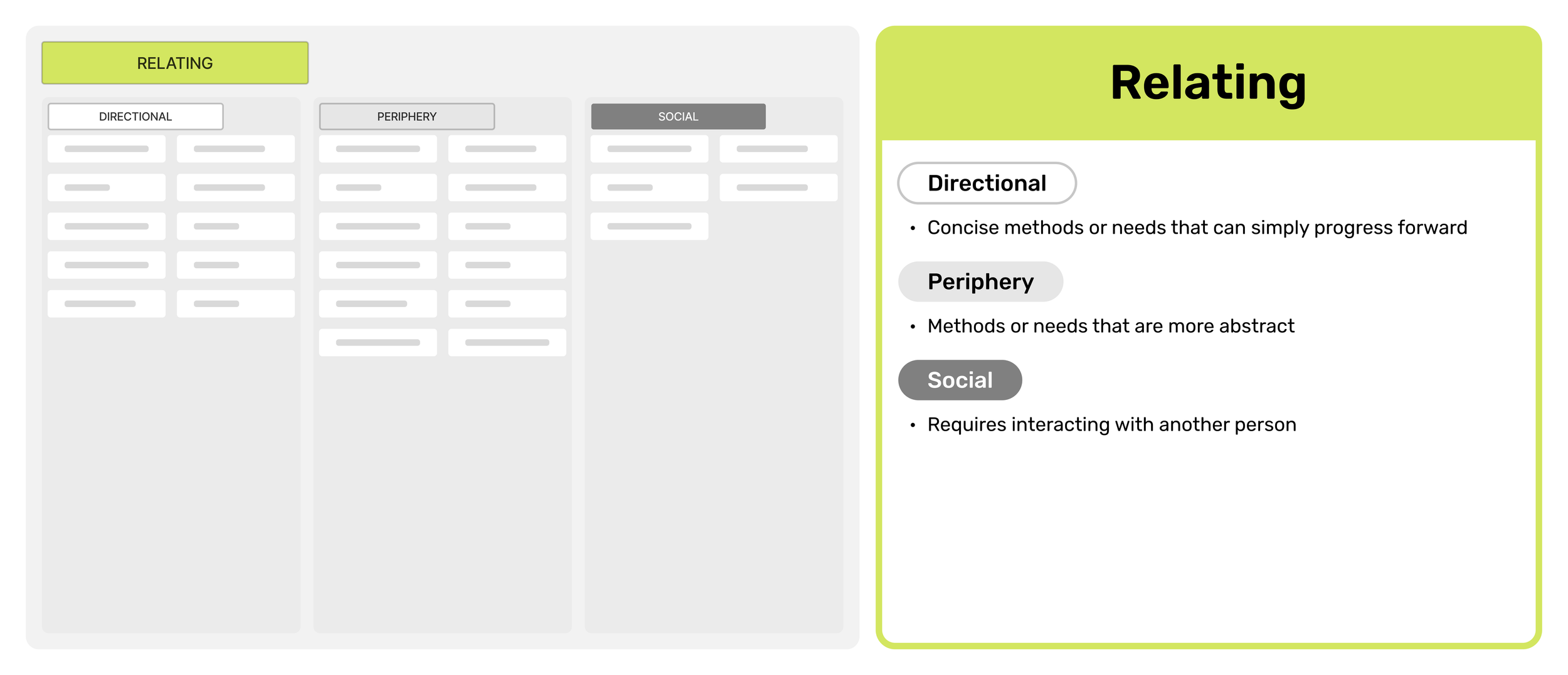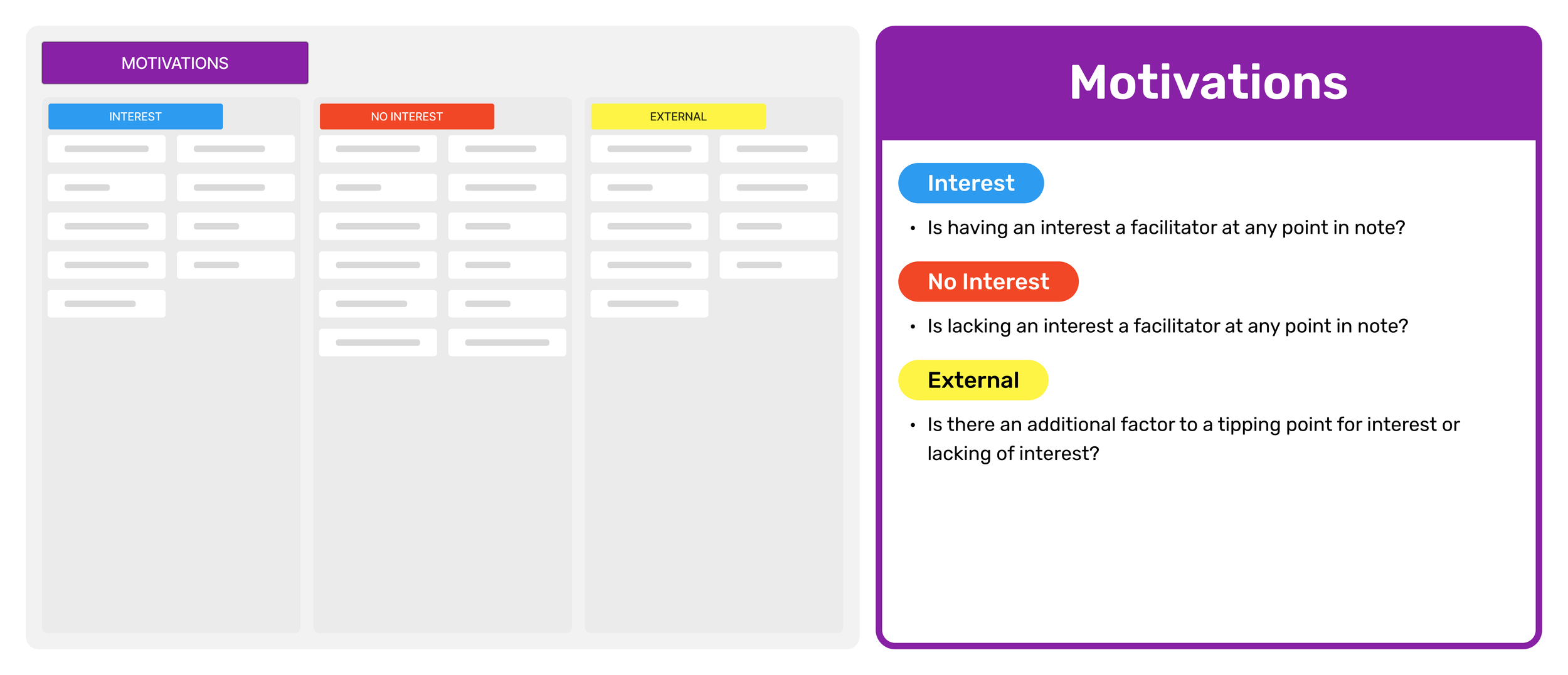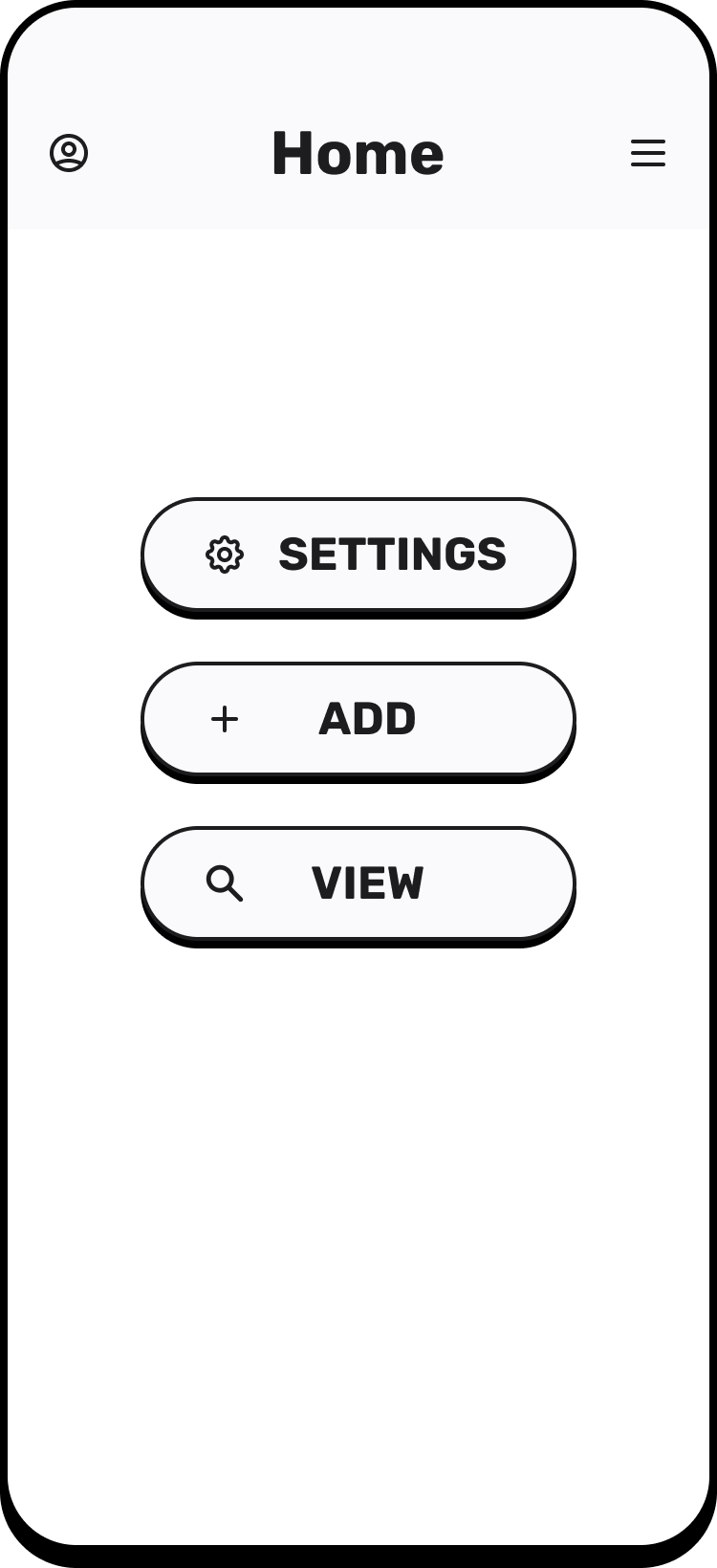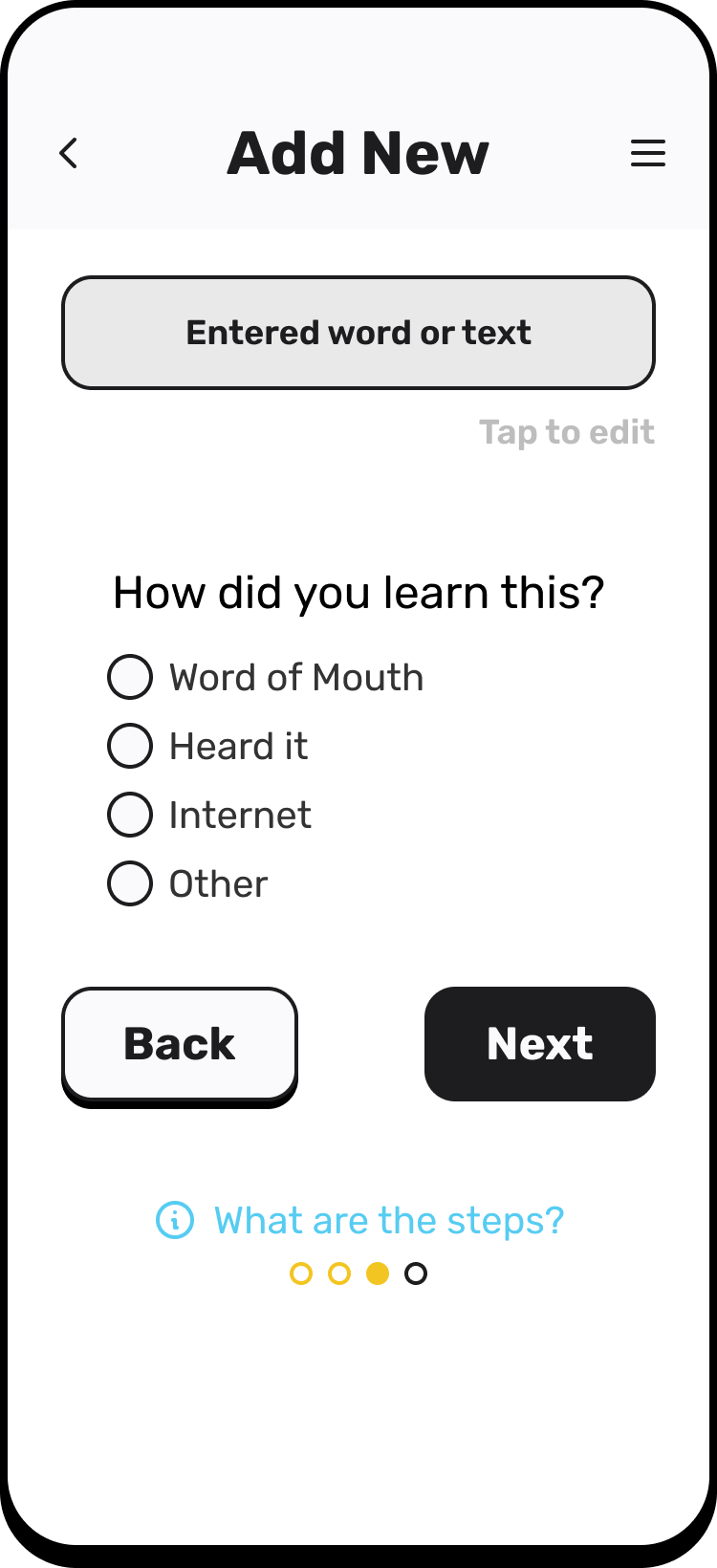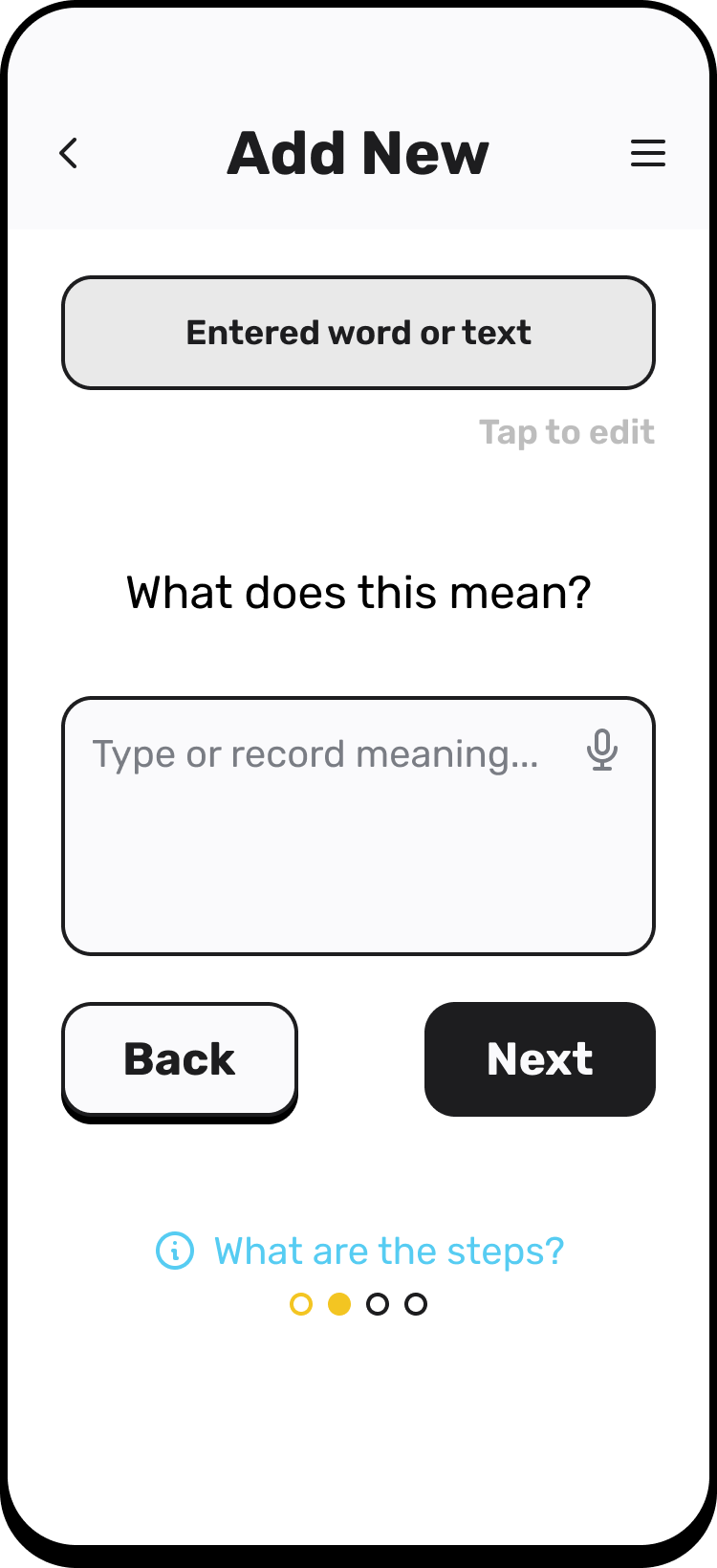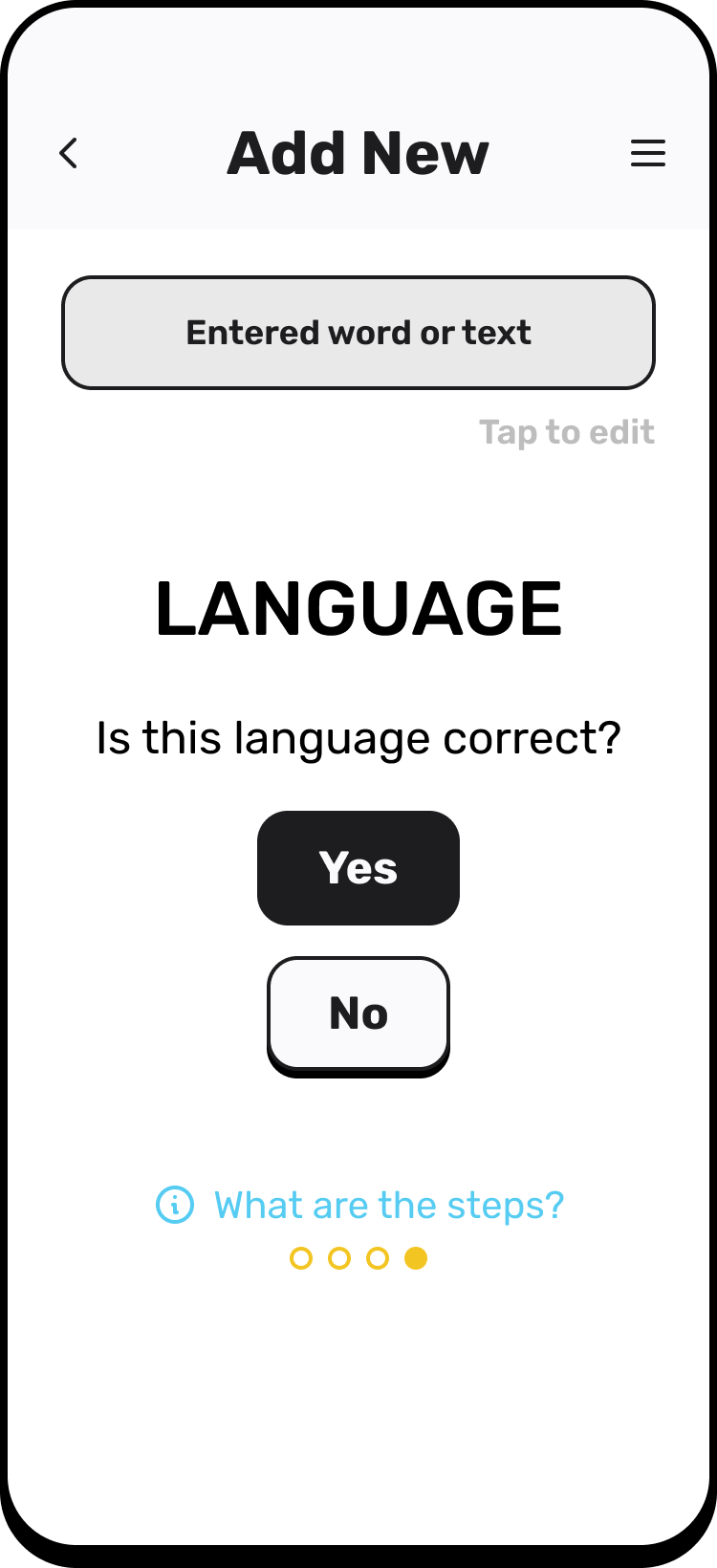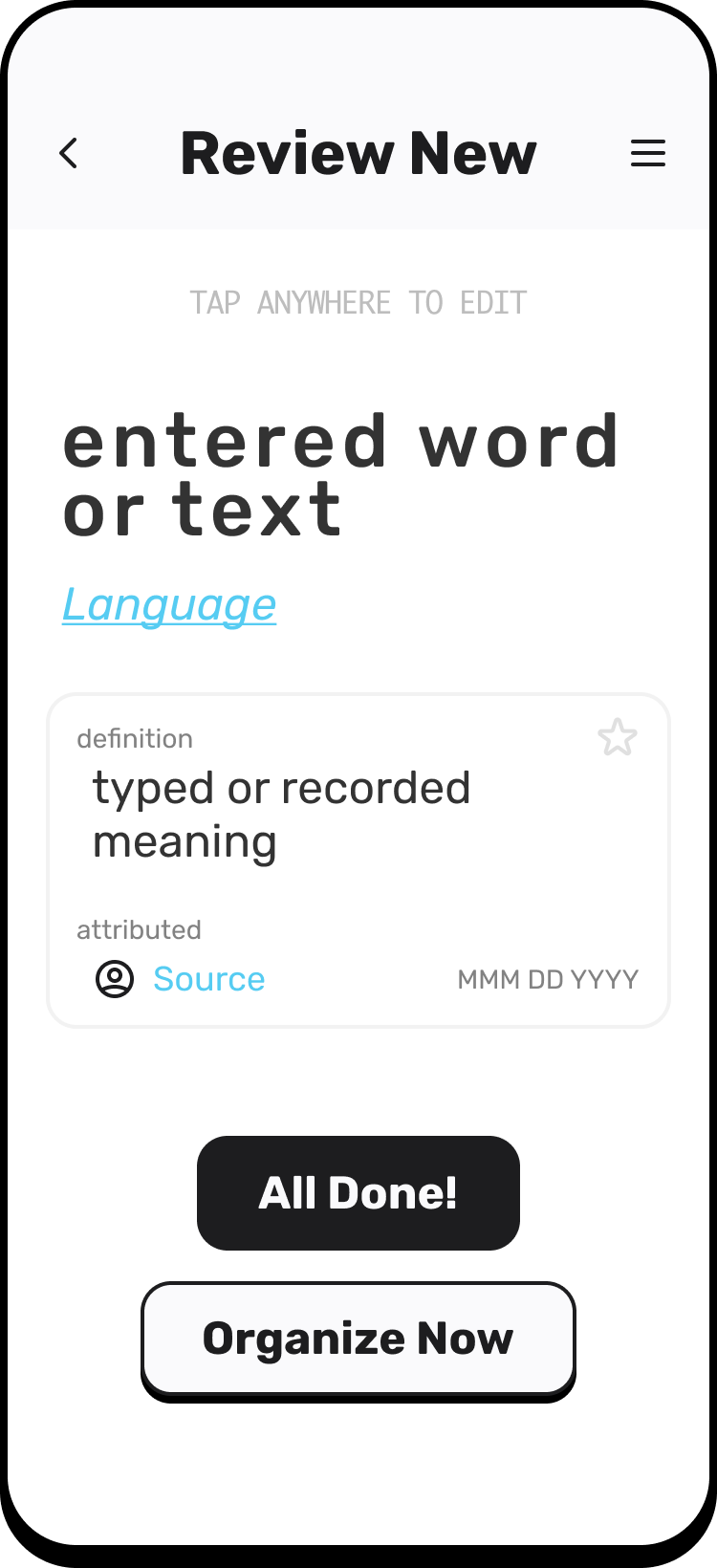
Language App
Exploring the creation and use of a hyper-editable, personal repository of words, expressions, and additional communicative methods as a means to learn. Includes research, prototypes, and plot twist.
Background
I have long held interests in communication methods, cultures, linguistics, and most relevant: languages. The exposure to a wide variety of these growing up was not only a privilege, but it allowed scattered and - unfortunately - ephemeral acquisition of the knowledge shared. I wanted a tool to help me remember these experiences for good, whether on my own or as a log to reference and refresh memory.
60 days
Timeline
My Role
Lead Researcher & Designer
Subject Matter Research
Competitive Analyses
Script Writing & User Interviews
Data Synthesizing
Information Architecture
Sketching, Mockups, Prototyping
Stakeholder Presentation

Initial Problem
I want a way to store and access words and phrases from other languages. Initial market research showed no suitable product.
Goal
To create a living directory of learned language that allows for quick archival and retrieval.
Approach
I created a simple workflow of what immediate actions would be needed based on the scenario of being in a conversation with friend.
Great! But what inspired these requirements? I didn’t outline any first, which is a mistake leading to early ideation of features I would like to see (for myself) in the product.
I corrected by setting these aside to focus on the users, the problem, and defining the initial product to provide feedback to begin the work.
Users
Individual engaging in foreign language with native speaker or media passively
Individual with varied interests, learning new language, and interacting with native speaker or media intentionally
Individual actively seeking foreign language study and engagements with native speaker or media
Product Defined
Digital tool to assist in language acquisition and practical conversation when interacting with native speakers and consumed media.
Minimum Requirements
Record word(s) and phrase(s) with definition
Be able to record quickly
Nice to Have
Ability to look up words through categories

Research
Preparation
With initial market research and a competitive analysis, there was some aid in narrowing down what ways users may have come across learning language in an intentional space or through tool usage.
I researched different learning types for further understanding the breadth of information I should be capturing in the interviews.
This includes talking with primary school teachers, language tutors, and school counselors.
Resources : Learning Types
VARK Research - Distribution of Learning Preferences. 2023, vark-learn.com/research-statistics/.
Khan, Ameer Hami Ad , et al. “Evidence-Based Approaches to Learning.” Advances in Medical Education and Practice, 2018, pmc.ncbi.nlm.nih.gov/articles/PMC6101737/pdf/amep-9-581.pdf.
Hussain, Imran. (2017). “Pedagogical Implications of VARK Model of Learning.” Journal of Literature, Languages and Linguistics, 2017, researchgate.net/publication/337274707_Pedagogical_Implications_of_VARK_Model_of_Learning.
Script
I defined the initial scope of the script and goal of the interviews. It is simple, open-ended, and styled to allow for a fluid conversation where information can be collected without the structure disrupting.
The script was broken into 6 general sections:
Understanding the user’s language background and any additional context
Understanding how the user learns
Giving a scenario and asking what the user’s approach would look like or to respond generally to the scenario
Additional prompts: exploring (with scenarios as ready references) in specifics their approach to retaining the information
Further investigation of discussed items, motivations, and pain points
Interviews
I selected individuals to interview based on the 3 criteria previously outlined. Interviews were recorded with consent, consisting largely of in-person with remote interviews supplementing. Interviewed individuals will return for user testing.
Initial Round
I interviewed 5 individuals to start. As I began to dissect the information, it wasn’t long to start seeing the scope broadening and a flaw appearing.
Starting with a small batch of interviews was incredibly helpful in understanding how information heavy & diverse this project would become, while also highlighting a major problem to be corrected with proceeding interviews.
Immediate Insights
Big range of learning types
Habits in learning looks to be key to understanding
Need a wider pool of individuals
with important attention to first insight
Looking at the Data
The glaring omission in the initial interviews was an absence of monolingual speakers.
Not only that, but every individual interviewed initially grew up learning an additional language concurrently with what they considered to be their native language (attributed to primary language spoken in household).
Additional Rounds
To correct, I selected and interviewed:
users who learned/are learning an additional language at a late age
users who come from monolingual households
users whose additional languages vary more greatly in language family connections

IMAGE: Interviews recorded into categories in cards. This mockup is for illustrative purposes only and is intentionally kept simple. More than 5 individuals were recorded.Synthesizing the Data
Combing through and understanding all this data was cumbersome, and it ultimately was digested into 4 layers, with a bonus for additional testing and ideation.
Interview Collection
i
Let’s understand the initial recording and organizing of information from the scripted interviews first before we break it down.
All the information and takeaways were organized to the following categories and into cards.
INTRODUCTION
Basic information more inline with what is expected from a user persona, ex. age, occupation, nationality, education, etc.
LANGUAGES
Languages spoken with proficiency, attempt, and family history/ties noted; language family and grouping also recorded
GEOGRAPHIC BACKGROUND
Basic geographic information on background, including work history and any time living away from home (family included) when relevant
LEARNING
What learning types have been historically helpful plus notes about experiences learning language or new things
FURTHER INVESTIGATION
Typically a follow-up on the learning section, zeroing in more on the emotional side or investigating decisions
SCENARIOS
Any relevant responses or connections to scenarios, including quotes
WHAT MOTIVATES YOU?
Understanding choices and responses with deeper investigation. Includes quotes and direct ties to language relationships and education
Breakdown of Cards – Overview
1a
The green section grouped together above is higher level information for great initial context and with extra data for deeper investigation at a later stage, but primarily sticking to the scope of the interviews and the goals, I broke the remaining categories into insights and pain points.
By combining all the cards together, it provided an overview of the dataset.
Learning Insights
Individuals showed little success relating fruitfully, but there is plenty of data about learning productivity. Plus many notes on tool.
Learning Paint Points
Individuals reported struggle learning with motivation and relating information, and there were many notes on tools.
Breakdown of Cards – Analyzing
1b
Patterns began to reveal themselves, and I grouped them accordingly (seen below in like-colors) for further analysis.

Identifying Patterns
2
The 4 predominant commonalities were defined and grouped under the following banners.
Please note: no mockup provided here for this step, but follows the same visual and organization as the other cards, however with each header being one listed below and the cards being white.
Ways identified how individual learns, plus what is or isn’t helpful when learning. Example: reading and writing is helpful, but speaking is not.
Mechanics
Falls under Mechanics, but is supplemental to traditional learning with helpful tactics.
Example: writing down notes in phone.
Tools
Falls under Mechanics, but a way to more deeply understand language presentation that is relevant to the individual’s learning.
Example: needs to see context of use with words or phrases.
Relating
Factors that push towards or away from the individual learning.
Example: I want to learn a second language to travel to that city alone.
Motivations
Further Investigation
3
Like previously (1b), I analyzed the cards grouped under the categories for further investigation. The cards within the categories (detailed above) were broken into sets of 3-4 each for deeper understanding.
Here is how I investigated each and defined where the data best fits within.

Final Breakdown
4
At this point, I have learned so much and understand where to go next.
Mechanics provided great insights already, however exploring the points of connection felt necessary.
I marked overlap and then visualized the data in a Venn Diagram (similar to mockup below) to identify the similarities and relationships.
IMAGE: (above) Mockup demonstrates revisiting this data to discover overlaps, seen in the color scheme of the highlighted cards.
IMAGE: (above) Mockup of Venn Diagram showcasing a more easily identifiable relationship within Mechanics.Takeaways
Interviews provided an immense amount of information regarding how the individuals did or did not learn
The Venn diagram shows the interconnected relationship of experiences when learning
This diagram highlights the high level of attention required of Mechanics in the user journey
Product features will have a close, highly impactful relationship here

Putting It Together
With the benefit of a clear, simple goal and minimum requirements, along with competitive analysis of products relating to language and archiving, it is clear that this product can use existing patterns and rely on expected features.
It is how the features are accessed that calls focus.
Because of the impact of features and an established design philosophy thanks to what I’ve learned from the interviews, synthesis, and research, the project’s attention now turns to light feature mapping. In the background, I am also collating and playing with task flow and how the larger system interacts with the features.

Features
24 features have been identified to be included and tested.
Features x Learning Types
In architecting the larger system, I wanted to see
how well do these features support different learning types
what is the general coverage of learning types supported
This was created based upon research and further tested by reaching out through different teachers.
Features x Accessibility
Continuing with architecting the system and weighing prioritization with succeeding in the product’s primary goal,
I wanted to see how well each feature is supporting how a user may learn
I wanted to see where gaps exist
I wanted to anticipate pain points
The scale of help-to-hurt began on my own research and validated through working with education professionals.
User Journey
Mapping the journey through information architecture, I can see the behavior of the app taking form. The highlighted area shows fluidity in action and freedom of the user to move in a non-linear way.

Creating the App
The research is there and I understand the product that I need to build. Crucially, how the pieces come together practically is missing. To ideate further, an MVP is made for user testing to provide insights to better shape this product.
Here we follow the user adding a new word or phrase in a sequential order.
i. Landing Page[Add] 1. Value[Add] 3. Attribute Source[Add] 2. Define[Add] 4. Language[Add] 5. Qualifications[Add] 6. ReviewBonus Mockup
Unrelated to this flow and further unrelated to the highlighted portion of the information architecture above.
A look at what a potential entry could entail once added and accounted for within the user’s log.

Now we stop…
or rather, we take a pause.
At this crossroad, depending upon team and resources, next steps would be either
to continue to mockup product for testing
to begin building the app with code (if not done already)
Generally, it’s making meaningful enough product with testing and validation to refine it towards launch.
Instead of continuing the role of designer, I am putting on a different hat to analyze what I have accomplished here and which best next steps to take.
Project Review
Meets all requirements
Built for users
Thoroughly researched
Ready for additional testing & scaling
Market match
Counterpoint
Considering the market competitiveness, the amount of financial resources required to build this app beyond MVP, and the wealth of insight from the users, it does not seem to be financially wise to continue this project as-is.
Pivoting Proposals
There are 2 viable options with soft lifts that are within reach.
1. Build out unique feature & refocus product behavior around.
With very little products geared directly towards hearing-impaired individuals, the draw pad feature stands to serve as a significant focal point allowing for creation, recording, and sharing unique sign language.
Sign language is largely unrepresented in SaaS and mobile platforms, and its lack of standardization leads to tech frequently failing to support the flexible and fluid language groups.
2. Shift market strategy from tool to hobby app.
Research shows clearly that the users with habit and success learning an additional language do not benefit incredibly from using this product as designed. Instead, it’s likely the casual features they will utilize. The product’s goal isn’t to serve as a primary learning tool, but our user must be engaged in language acquisition at some level.
2024 market reports demonstrate users seeking socially-powered apps and platforms focused around a hobby. 2025 validates and grows on this trend.
Lacking market competitiveness, user habits, and this product’s distinct approach to language acquisition, pivoting to a hobby app with increased attention towards social interaction seems a natural and smart step.







